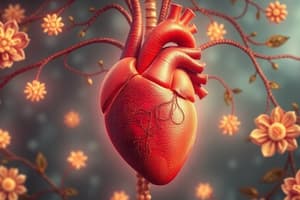Podcast
Questions and Answers
What is the primary function of the human heart?
What is the primary function of the human heart?
- Providing structural support to the body
- Generating electrical impulses to control muscle movement
- Delivering nutrients to all tissues in the body (correct)
- Pumping oxygen to the lungs
Which system is responsible for emotional processing and memory formation?
Which system is responsible for emotional processing and memory formation?
- Endocrine system
- Nervous system (correct)
- Immune system
- Circulatory system
Where does the spinal cord originate from in the human body?
Where does the spinal cord originate from in the human body?
- Lower back region
- Base of the brain (correct)
- Neck region
- Chest region
Which bodily process is mainly regulated by the circulatory system?
Which bodily process is mainly regulated by the circulatory system?
Which part of the nervous system facilitates voluntary body movements?
Which part of the nervous system facilitates voluntary body movements?
What role do blood vessels play in the circulatory system?
What role do blood vessels play in the circulatory system?
Which type of blood vessel carries deoxygenated blood back to the heart?
Which type of blood vessel carries deoxygenated blood back to the heart?
What is the main function of sensory (afferent) neurons?
What is the main function of sensory (afferent) neurons?
In the nervous system, which type of neuron relays commands from the CNS to effector organs?
In the nervous system, which type of neuron relays commands from the CNS to effector organs?
What is the primary function of capillaries in the circulatory system?
What is the primary function of capillaries in the circulatory system?
Which part of the body is primarily responsible for regulating homeostasis and coordinating body functions?
Which part of the body is primarily responsible for regulating homeostasis and coordinating body functions?
What is the function of the spinal cord in the nervous system?
What is the function of the spinal cord in the nervous system?
Study Notes
Nervous System and Circulatory Systems: An Overview of Interconnected Components
The nervous system and circulatory system form two foundational structures within our bodies, each with distinct roles yet intimately connected through intricate networks and interdependent processes. In this exploration, we'll delve into the components of these systems—blood vessels, neurons, brain functions, spinal cord, and heart anatomy—to better understand their individual contributions toward maintaining homeostasis and overall health.
Blood Vessels
Blood vessels serve as the highways of the circulatory system, transporting oxygen, nutrients, hormones, waste products, and other essential substances throughout the body. They can be categorized according to size and function: arteries carry oxygenated blood away from the heart; veins return deoxygenated blood back to it; and capillaries facilitate exchanges between cells and blood.
Neurons
Neurons are specialized cells responsible for transmitting electrical signals called action potentials. These nerve impulses constitute the primary means by which the nervous system communicates information across various parts of the body. There exist three main types of neurons based on structure and function: sensory (afferent) neurons convey incoming sensations; motor (efferent) neurons relay commands from the central nervous system (CNS) to effector organs; and interneurons facilitate communication among neurons within the CNS.
Brain Functions
Atop the hierarchy of the nervous system lies the brain, the most complex organ known to humankind. Within its folds reside vast numbers of neuronal connections enabling us to perform diverse tasks such as thinking, reasoning, learning, memory formation, emotional processing, perception, coordination, movement control, and consciousness.
Spinal Cord
Extending downward from the base of the brain, the spinal cord serves as the major conduit linking the peripheral nerves to the CNS. This cylinder-shaped structure is housed within the vertebral column and facilitates transmission of both somatic (voluntary body movements) and autonomic (involuntary bodily activities) messages.
Heart Anatomy
As the engine powering circulation, the human heart pumps approximately five liters of blood per minute, providing life-sustaining nourishment to all tissues throughout the body. Its four chambers work in unison to ensure efficient delivery of oxygen-rich blood to cells while simultaneously collecting carbon dioxide waste products for removal via respiration.
Synergistic Integration
In essence, the interplay between the nervous and circulatory systems shapes nearly every aspect of our existence. When functioning optimally, they harmoniously collaborate to sustain critical physiological processes like thermoregulation, digestion, immune response, wound healing, and even mood management. Ultimately, recognizing how closely related these systems truly are helps underscore the importance of maintaining whole-body wellness.
Studying That Suits You
Use AI to generate personalized quizzes and flashcards to suit your learning preferences.
Description
Explore the intricate networks and interdependent processes between the nervous system and circulatory system. Delve into the components such as blood vessels, neurons, brain functions, spinal cord, and heart anatomy to understand their roles in maintaining homeostasis and overall health.




